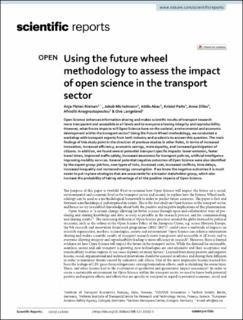| dc.contributor.author | Nielsen, Anja Fleten | |
| dc.contributor.author | Michelmann, Jakob | |
| dc.contributor.author | Akac, Attila | |
| dc.contributor.author | Palts, Kristel | |
| dc.contributor.author | Zilles, Anne | |
| dc.contributor.author | Anagnostopoulou, Afroditi | |
| dc.contributor.author | Langeland, Ove | |
| dc.coverage.spatial | Norway, Oslo | en_US |
| dc.date.accessioned | 2023-06-29T10:44:57Z | |
| dc.date.available | 2023-06-29T10:44:57Z | |
| dc.date.created | 2023-05-10T12:35:50Z | |
| dc.date.issued | 2023-04-12 | |
| dc.identifier.citation | Scientific Reports. 2023, 13 (1), 1-15. | en_US |
| dc.identifier.issn | 2045-2322 | |
| dc.identifier.uri | https://hdl.handle.net/11250/3074333 | |
| dc.description | Nielsen, A.F., Michelmann, J., Akac, A. et al. Using the future wheel methodology to assess the impact of open science in the transport sector. Sci Rep 13, 6000 (2023). https://doi.org/10.1038/s41598-023-33102-5 | en_US |
| dc.description.abstract | Open Science enhances information sharing and makes scientific results of transport research more transparent and accessible at all levels and to everyone allowing integrity and reproducibility. However, what future impacts will Open Science have on the societal, environmental and economic development within the transport sector? Using the Future Wheel methodology, we conducted a workshop with transport experts from both industry and academia to answer this question. The main findings of this study point in the direction of previous studies in other fields, in terms of increased innovation, increased efficiency, economic savings, more equality, and increased participation of citizens. In addition, we found several potential transport specific impacts: lower emission, faster travel times, improved traffic safety, increased awareness for transport policies, artificial intelligence improving mobility services. Several potential negative outcomes of Open Science were also identified by the expert group: job loss, new types of risks, increased cost, increased conflicts, time delays, increased inequality and increased energy consumption. If we know the negative outcomes it is much easier to put in place strategies that are sustainable for a broader stakeholder group, which also increase the probability of taking advantage of all the positive impacts of Open Science. | en_US |
| dc.language.iso | eng | en_US |
| dc.publisher | Nature Research | en_US |
| dc.rights | Navngivelse 4.0 Internasjonal | * |
| dc.rights.uri | http://creativecommons.org/licenses/by/4.0/deed.no | * |
| dc.title | Using the future wheel methodology to assess the impact of open science in the transport sector | en_US |
| dc.title.alternative | Using the future wheel methodology to assess the impact of open science in the transport sector | en_US |
| dc.type | Journal article | en_US |
| dc.type | Peer reviewed | en_US |
| dc.rights.holder | © The Author(s) 2023 | en_US |
| dc.source.articlenumber | 6000 | en_US |
| dc.description.version | publishedVersion | en_US |
| cristin.ispublished | true | |
| cristin.fulltext | original | |
| cristin.qualitycode | 1 | |
| dc.identifier.doi | 10.1038/s41598-023-33102-5 | |
| dc.identifier.cristin | 2146726 | |
| dc.source.journal | Scientific Reports | en_US |
| dc.source.volume | 13 | en_US |
| dc.source.issue | 1 | en_US |
| dc.source.pagenumber | 1-15 | en_US |
| dc.relation.project | EC/H2020/824323 | en_US |

